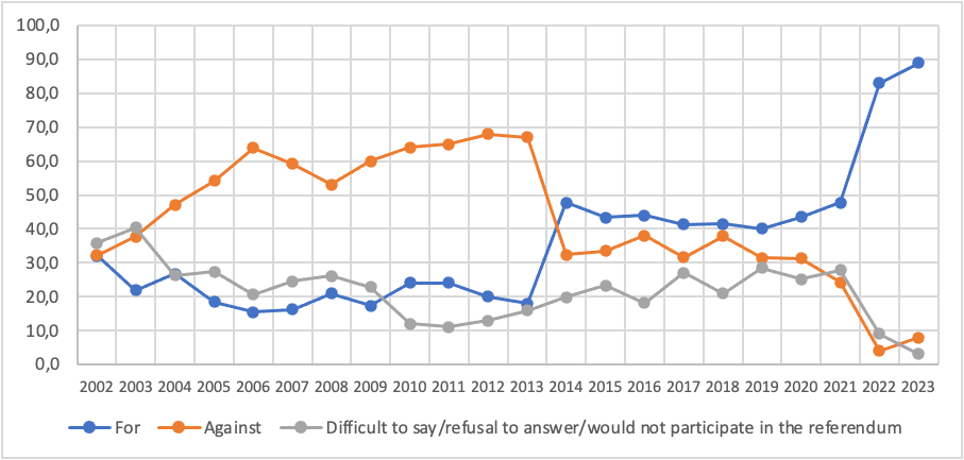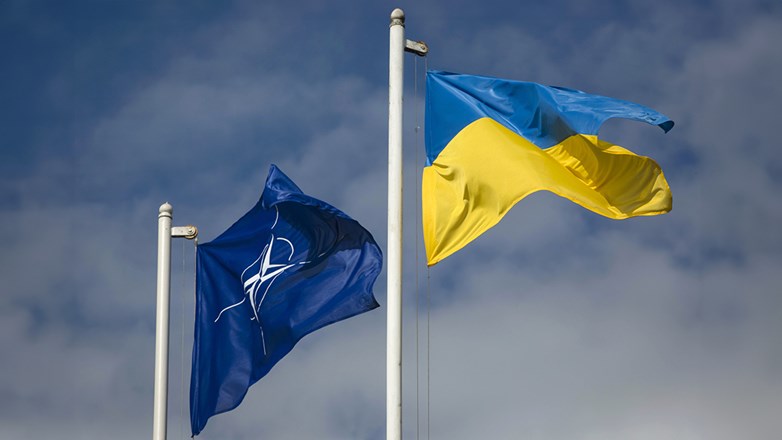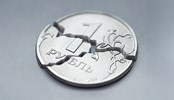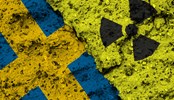Ukraine and NATO – Evidence from public opinion surveys
A recent survey on Ukrainians’ attitudes towards a Ukrainian NATO membership shows that 89 percent would support joining the military alliance in a referendum – the highest level of support in the country’s history. Moreover, the convergence of membership attitudes between Western and Eastern regions in Ukraine displays a real loss of trust in Eurasian (pro-Russian) relations as a vector of development for Ukraine. This brief offers some perspectives on how public opinion has changed and what have been the crucial turning points. In particular, the brief digs deeper into the evolution of opinion against a NATO membership, as well as regional differences in attitudes. It also shows how every round of Russian aggression eventually has led to public opinion alignment. These changes not only concern a NATO membership but reflect a deeper transformation of societal values and a consolidation of the Ukrainian national identity, strengthening the grounds for a more democratic society.
The continued Russian aggression on Ukraine has disclosed several deep-running issues that have for long been undercurrents in Ukraine’s history and whose resolution is a key determinant of the country’s future. One such issue is the relationship with NATO, including a potential accession into the alliance.
The most recent survey on Ukrainians’ attitudes towards Ukrainian NATO membership, conducted in May-June 2023, shows that 89 percent of the respondents would support it in a referendum, 8 percent would not, while 3 percent of the respondents found it difficult to say (KIIS, 2023). The survey (which excludes occupied territories where it was unfeasible to conduct the survey) also shows the lowest ever gap in terms of geographic spread. 93 percent were in favour of membership in the Western regions and 79 percent in the Eastern regions, the traditionally pro-Russian areas where most of the Russian ethnic minority resides. In comparison, in 2017, 71 percent were in support of a NATO membership in the Western regions and 32 percent in the Eastern regions, respectively (Kermach, 2017).
NATO membership support in Ukraine over time
To gain a deeper understanding of how the public’s opinion on a NATO membership has changed over time, it is suitable to start in 2002, when former President Leonid Kuchma first announced Ukraine’s aspiration to join NATO. At that point the Ukrainian society could be almost equally divided into three categories; those in favour of joining NATO, those against it, and those who refused to take a stance/found it difficult to say/would not vote in a referendum (hereafter referred to as “indecisive respondents”), depicted in Figure 1. This was a very natural consequence of the late 1990s/early 2000s coexisting positive attitudes to both geopolitical directions – towards NATO and the EU, but also towards Eurasian integration.
Figure 1. Attitudes to joining NATO among Ukrainians, 2002-2023.

Source: “30 Years of Independence”, 2021; KIIS, 2023; Rating Group, 2023 and author’s compilations.
One framework for understanding this is the concept of social ambivalence, which has been highlighted as very typical for transitional societies such as Ukraine. For example, Reznik (2022) argues that, in the case of Ukraine the main reason for ambivalent geopolitical orientation is the need for “ideological ‘reconciliation’ of two civilizational directions different in essence and meaning within an unbalanced identity” (Reznik, 2022). Similarly, Golovakha and Panina (2003) suggest that in Ukraine, society simultaneously accepts the old social institutions, which have lost their legality during the transition times but have remained legitimate in the view of the public, and the new social institutions, which have gained legal recognition but have not yet been accepted by society. Ukraine is not unique in this context, similar processes have occurred in many transition countries, for instance in Poland, the Czech Republic, Hungary, Slovakia, Estonia, Lithuania, Latvia and others (see, for instance, Roland, 2000; Murrell, 2003; Gruszewska, 2014; and Becker, 2019). This literature documents a mismatch between old and new institutional structures in transforming countries, strongly associated with low levels of trust in society, resistance to new ideas, strong attachment to traditional behaviors and low social activity levels within society. However, such discordance can change drastically due to shocks facing a society, as illustrated by the change in attitudes towards a NATO membership in Ukraine from the early 2000s and onwards.
In the first decade of the 21st century the Ukrainian society gradually became more aligned against joining NATO. This process intensified after 2010, when Viktor Yanukovych was elected as the President of Ukraine. Soon after the election, the Verkhovna Rada (the Ukrainian Parliament) adopted the law “On the Principles of Internal and Foreign Policy”, establishing the principle of “non-alignment” (Verkhovna Rada of Ukraine, 2010). This implied a Ukrainian commitment not to participate in any military political alliances, including NATO. This decision, alongside successful efforts from pro-Russian authorities in the Eastern regions – including anti-NATO propaganda – resulted in as low as 18 percent support for NATO membership in 2013, and 67 percent of the respondents stating to be against a membership (see Figure 1). Such anti-NATO sentiments can be argued to not only have prepared the grounds for, but also to have been explicitly used as an argument for the Russian aggression in 2014.
However, the illegal annexation of Crimea and the Russian aggression in Donbas in 2014 drastically changed the public’s opinion on the military alliance, increasing the share of NATO membership supporters to close to half of the population and thus exceeding the share of opposing or indecisive respondents for the first time in history. At that point 47,8 percent of Ukrainians were in favor of joining the alliance and 32,4 percent were against it (“30 Years of Independence”, 2021), and in 2014 the “non-alignment” principle was officially repealed. It was even officially stated in the Comment On Amendments to the Law of Ukraine “On Principles of Internal and Foreign Policy”) that the policy had been a decisive factor for the Russian aggression in 2014: “In view of this, the further continuation of the so-called non-alignment policy, which has already led to the loss of Ukraine’s territorial integrity, is contrary to national interests, poses a constant threat to Ukraine’s state sovereignty and territorial integrity, holds back the processes of socio-political and economic reform of the country, and limits Ukraine’s prospects to become a developed European democratic country within the European Union.” (Verkhovna Rada of Ukraine, 2014).
Changes in public opinion in Ukraine is however not only limited to NATO membership attitudes. Naturally, there have been changes in election outcomes and voting patterns as well. Recently, Munroe et al. (2023) found a significant shift in voting patterns in Ukraine after 2014, reporting a dramatic decline in pro-Russian votes in Donetsk, Dnipropetrovsk and Odessa regions that had all traditionally been pro-Russian. Still, about one third of the respondents were continuously negative towards NATO until 2021, when the share of those in opposition of a NATO membership dropped to 24 percent. Potential explanations for the pertaining negative attitudes include a remaining influence from pro-Russian authorities in the Eastern and Southern parts of the country, along with a lack of knowledge and awareness about NATO among the population.
Motives, regional variations, and information gaps
In this context, it is essential to highlight the Ukrainian’s motives for support, or scepticism towards NATO membership. A nation-wide survey from 2017 shows that among the majority of NATO supporters in Ukraine the dominant motive was the expectation of “security guarantees for Ukraine” (86 percent). On the contrary, those who did not support joining the alliance expressed concerns that a NATO membership might “draw Ukraine into NATO’s military actions” (44 percent) or “provoke Russia to direct military aggression” (28 percent). 27 percent were convinced that “Ukraine, in principle, should be a non-aligned state” (27 percent), and finally, 22 percent were worried that “foreigners and foreign capital will start to rule in Ukraine” (DIF, 2017).
Stereotypes of NATO as either protection or conversely, a threat, for Ukraine are subject to significant regional differences. While in Western and Central Ukraine the perception of NATO as protection clearly prevailed (81 and 68 percent, respectively), attitudes in the Southern and Eastern parts were more uncertain. About the same number of respondents (19 percent) considered NATO as both protection and a threat, while 25 percent of the respondents in the South and 30 percent in Eastern Ukraine didn’t see NATO as either.
The basis for these opinions is most likely a lack of effective information and a lack of understanding of the alliance, as well as the complex geopolitical dynamics involving it. Research has attributed negative attitudes towards NATO to surviving Cold War stereotypes and a lack of information concerning NATO’s specifics, functions, decision-making procedures, and the rights and obligations of member states (Kermach, 2017).
In the 2017 survey, almost every other Ukrainian admitted that they were not well informed about NATO. Only 55 percent of the respondents claimed to “know something about NATO”, while 22 percent said they knew virtually nothing about it. However, a majority of Ukrainians (55 percent) “would like to know more” about NATO, while about a third (36 percent) of the respondents did not express such interest (see Table 1). Also in this regard, regional differences are remarkable. In Western and Central Ukraine, interest in NATO was much higher in 2017 than in the Eastern and Southern parts of the country.
Table 1. Interest in knowing more about NATO among Ukrainians in 2017.

Note: Responses to the question: “Would you like to know more about NATO?”
Source: DIF, 2017.
Public opinion consolidation
The most drastic change in attitudes towards a NATO membership has however occurred after the full-scale Russian invasion of Ukraine in February 2022, with the public almost converging in their support of a NATO membership. The ongoing share of NATO supporters exceeds 85 percent, and the increase in this group draws, to an almost equal extent, both from the number of those who previously were against the alliance and those who were previously indecisive. For the majority of those who consistently considered the “non-alignment” policy of Ukraine as optimal (26,6 percent according to Kermach (2017)), it has become obvious that this “non-alignment” strategy has failed to provide effective security guarantees.
Moreover, the perception of a NATO membership as a security guarantee is also changing. In the 2022 Kyiv International Institute of Sociology (KIIS) survey, just below 40 percent of the respondents considered a NATO membership as the ultimate and only security guarantee, while approximately the same number were willing to accept other security guarantees. In the 2023 survey, the share of the former response category increased to 58 percent (with a slight difference within regions – 64 percent in the West and 48 percent in Eastern Ukraine), – while the latter dropped to 25 percent. Furthermore, 76 percent were not willing to accept forgoing a NATO membership as a condition for peace (KIIS, 2023).
Conclusion
Public opinion in Ukraine, including attitudes towards a NATO membership, has been drastically affected by the Russian aggression in 2014, and even more so by the ongoing war. As survey results show, each subsequent round of Russian aggression on Ukraine has only increased the share of NATO membership supporters and decreased the number of respondents indecisive on whether Ukraine should join NATO. Additionally, regional differences in attitudes between the Eastern and Western parts of Ukraine have also smoothened. These changes imply a deep transformation in societal views, where the meaning of living in peace for Ukrainians has transformed from the idea of “non-alignment” into perceiving a NATO membership as a security guarantee and a prerequisite for future peace.
While the transformation of public opinion is important per se, it is only one example of the groundbreaking changes the Ukrainian society has especially undertaken since the invasion in 2022. The necessity to fight the Russian invasion brought about unprecedented consolidation and feelings of a national identity. This, in turn, provides an essential foundation for building trust and active political participation, strengthening the grounds for an effective democratic society.
List of references
Disclaimer: Opinions expressed in events, policy briefs, working papers and other publications are those of the authors and/or speakers; they do not necessarily reflect those of SITE, the FREE Network and its research institutes.
Photo: Drop of Light, Shutterstock




